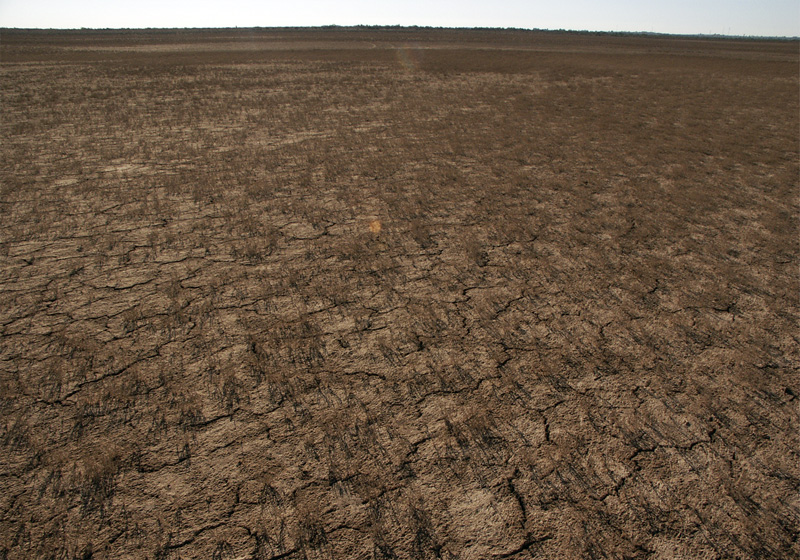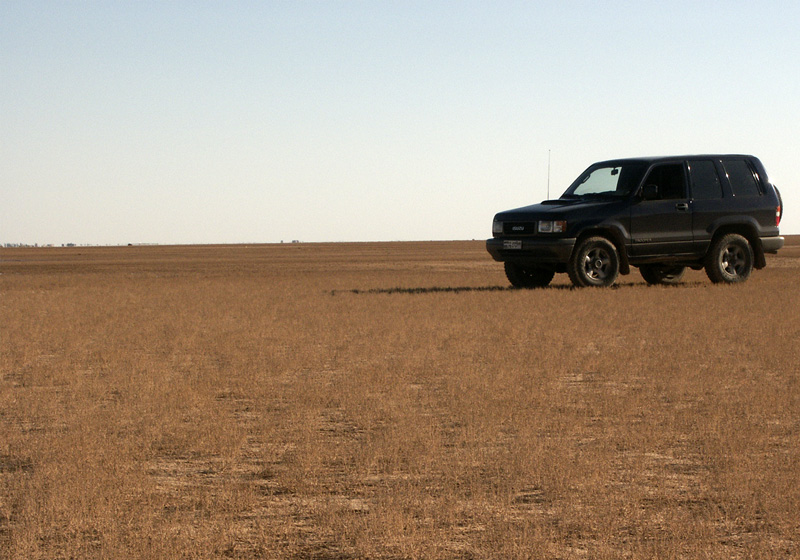Hunting Meteorites

At low gear, the 4x4 was moving at the speed of lazy walk. I opened the door of the car to be able to look down as the cracked mud passed smoothly under the wheels. Like stepping down from a low-flying-carpet, I left the car to keep on driving itself, as for miles in all directions there is nothing that the car can hit.
This is the mudflat of “Gaa’ Al Banzeen”, somewhere to the east of Azraq, and now I am walking comfortably with my eyes scanning for any suspicious-looking stones. The car gently follows me like a loyal pet or a metal robot. In this way I can cover more linear area, if I had stopped the car I would have to walk back to it. The speed was so slow that I can reach the icebox for an apple or some water, and the moving vehicle follows me with a symphony orchestra playing, in the highest standards, Rachmaninov's symphony “The Isle of the Dead”.

Most meteorites have been recovered from deserts (both hot and cold). After Antarctica – were meteorites have been collecting on ice for millions of years- hot deserts are the second best place to search. Mudflats in Jordan are particularly good, as meteorites can be easily distinguished from the surrounding stoneless dry-mud.
If you find a heavy stone that feels like iron, examine the crust. Meteorites enter the earth’s atmosphere at a great speed. Upon friction with air, their outer crust ignites, and a thin melting layer preserves the stripes created by the fast passing wind. At the same time the inner part of the stone remains freezing cold, retaining the temperature of outer space, the time it takes a crust to ignite is seconds, too short for temperature to travel inwards. A falling meteorite is like a chunk of ice with a melting and burning surface.
In Jordan and elsewhere around the world, meteorites have been falling for millions of years. One might find a “fossilized meteorite”, but on mudflats, it is more likely that you come across a meteorite that has struck earth during the last few years, as mudflats keep a surface that gets new mud every rainy season. In this case a meteorite found on mudflats would retain a fresh crust, relatively not eroded or oxidized. You might also find the striped, melted-looking crust only on some parts of the surface - in this case you have a fragment of a bigger meteorite that have split upon impact or later in time, and you should look around for the rest of the pieces.
From outer space, meteorites fall randomly over the earth’s surface. They come in all sizes, from as small as a speck of dust to as big as a house. It is estimated that the earth’s gravity attracts as much as 40,000 tons of extraterrestrial dust each year. The smallest micrometeorites would not melt as they pass through the earth’s atmosphere, whereas bigger pieces of dust ignite in friction with the atmosphere to create shooting stars or meteors.
You might be lucky to find a meteorite in one of the mudflats. You might even be luckier to witness one falling near you.
Although Jordan has no historical record of any meteorite casualties, scholars internationally have compiled cases of meteorite impacts that caused damage or death. In the twentieth century alone many incidents were recorded. In 1929 a meteorite killed one person at a wedding party, and in 1907 an entire family was killed by a meteorite fall in the Weng-li district of China. In separate incidents, in the course of the last century, five cars have been struck (without loss of life). The strangest incident happened in Washington State in 1955, when a pair of meteorites pierced through the dome of an amateur’s telescope, setting books of astronomy on fire.
Wearing a safety helmet in the desert would be completely impractical, and in case of impact, it wouldn’t help anyway.
This is a cool summer; the eastern desert remains a suitable destination, best visited in days of westerly breeze and few low clouds. Finding a meteorite is not easy, I've never found any yet, but you might be lucky. Mudflats are ideal to look for meteorites, since they have no or very few stones; you can search a large surface in a short period of time examining each stone you come across. Look for stones that have the weight of iron, meteorites are found in different compositions ranging from irons to stony-irons and stones. A distinguishing feature would be a black fusion crust, especially if the meteorite has fallen recently, look for smooth surface, furrowed or covered with shallow depressions. If you find some stones with unusual, metallic, thin crust and you think they might be from outer space; the only way to find out would be send them to the Department of Geology at the Jordan University. Ideally meteorites should not be kept in private collections –they should be made available for scientific research. The best destination for mudflats is around Azraq, some 20km to the northwest, after the farms to the east, and all the way between the road to Iraq and the Syrian borders. You can also try mudflats east of Deeseh or Jafr. Carry a lot of water, a hat, and a good sunblock. Good luck.